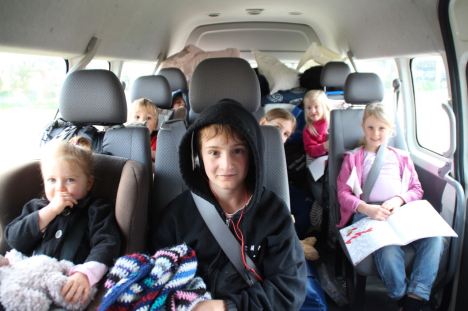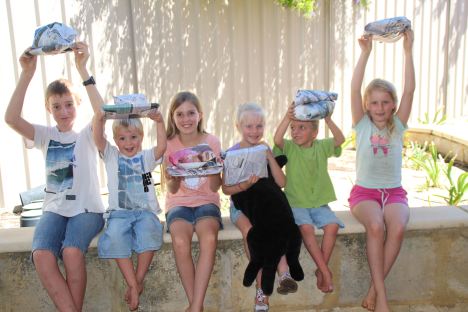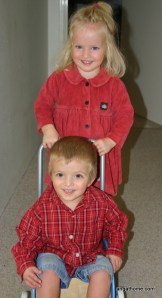
I am a task-orientated person. As a choleric/melancholy I can fairly easily get this family vehicle going and keep it going. I enjoy planning and schedules and all the tools and techniques that make life run more smoothly. The danger however lies in my focus becoming all about getting “stuff” done (organizing my vehicle and making it run more smoothly) while neglecting to fill up the tank – the love tanks of my children that is.
The concept of the 5 love languages in brief is that we each give and receive love in 5 ways; quality time, acts of service, words of encouragement, physical touch and gift giving. Each time we do or say something that meets one of these areas we are giving our children a love tank top-up.
As the children come to ask me questions, show me their latest creation or tell me their latest dream in every miniscule detail it can be easy to see these interruptions as things that slow down my vehicle (interrupting my plan for the day) and react by brushing them aside, missing an opportunity to add a little top up to their love tank.

Instead of listening with my full attention, I might keep my eyes on the computer and make vague listening noises in their general direction, or perhaps tell them to come back and tell me at the end of room time, or to save it for their evening “talking time” around the dinner table. In the end it all amounts to the same message; what I am doing is more important than you.
If I keep neglecting to top up their tanks they will get emptier and emptier and eventually this usually leads to a major catastrophe. This equivalent of a tire blow-out or radiator overheating brings the family vehicle to a violent stop and requires lots of time and attention to get things moving again.
In the end, if I take a look at the time involved, it would have been far quicker and a lot easier for everyone if I had used those few minutes along the way to give a little love. Five minutes to hear their dream retell, 2 minutes to listen attentively and admire the latest creation, seconds to notice the job well done that they are desiring to show me. What it takes is for me to slow it down a gear and cruise along in 4th instead of tear along in 5th being too busy to notice the needs. The vehicle keeps moving, everything eventually gets done and life is happier for everyone. Instead, the tanks are empty and we are stranded on the side of the road trying to fill up an empty and leaking tank.
Ensuring you have a special date or another event planned on a regular basis will take care of filling the love tank to some extent, but one burst of filling doesn’t make up for the continual lack of filling that has gone on all through the week. It’s like pouring in premium oil but forgetting the fuel.

Of course different children have different needs and some require less time that others. A quick tank top-up for one may be as simple as spending 10 minutes tidying out the drawers of their desk for them; an act of service. For another, bringing home a new pink toothbrush tops them up; gift giving. Making sure I start my 4 year old’s day with a cuddle, give him a piggy-back to nap time, tickle him on the way past in the afternoon and have a quick rock on the rocking chair before bed is the continual topping up he needs as a physical touch boy. Writing a ‘well done, I see you are working very hard’ message as I correct another child’s maths for the day gives them the words of encouragement boost they are needing. All of these things take mere minutes and don’t stop the vehicle from ticking along nicely.
The quality time children are the ones that do take time. They need the little top-ups along the way plus MORE. But if you are continually topping up then it reduces the need for the huge fill-up of a bottomless tank that seems to leak right on out again as soon as you finish.
I often get asked how I manage 7 children. This sums up the danger – I could easily become nothing but a manager. I need to proactively set myself into relational mode, change down a gear and use the little moments to keep topping up along the way.
A couple of strategies for task orientated personalities:
- Write focus time and planned extra minutes into your routine so that it becomes a task. You are less likely to feel like you are wasting time that you should be spending doing something else. Plan extra moments at transition periods so that you have the few minutes here and there to give a little top-up.
- Ensure that you have focus time with your toddlers early in the day. You might sit them on your lap for a story, have a cuddle in the rocking chair or do a puzzle together to top them up before expecting them to do a long alone period like playpen time. Several smaller timeslots through the day is often more effective than one marathon session for little ones. Older children will wait if they know their time is coming.
- Deal with the heart needs as they arise rather than waiting for the engine to overheat later. Sometimes you will need to pull the vehicle over, come to a complete stop and deal with the issues.
- Give full eye contact – you’ll be surprised at how little time it actually takes to hear the interruption in full when you stop and focus.
- If you really can’t stop, ask them to put the timer on for 20 minutes (or whatever time will work) and come back to you when they hear it beep. They know you won’t forget and you can’t make an excuse the next time.
- Give the child who constantly interrupts during room time (or any other period when they should be alone) 3 interrupt tokens – after they use up their 3 chances there is no coming back unless it is an emergency.
- Find activities that you like to do with the children and use them as one-on-one time. I like to sew, bake, build a Duplo house or other tasks that feel like we are getting somewhere. I can’t stand playing cars on the floor! It’s got to be something the child enjoys too of course.
- Special dates on planned occasions. There are many ways to do these that do not have to be too expensive or difficult to put together. I have a post on that here.
Filed under: Family nights, marriage & relationship building | Tagged: father/son dates, love languages, love tank, mother/daughter dates, personality types | 7 Comments »







































